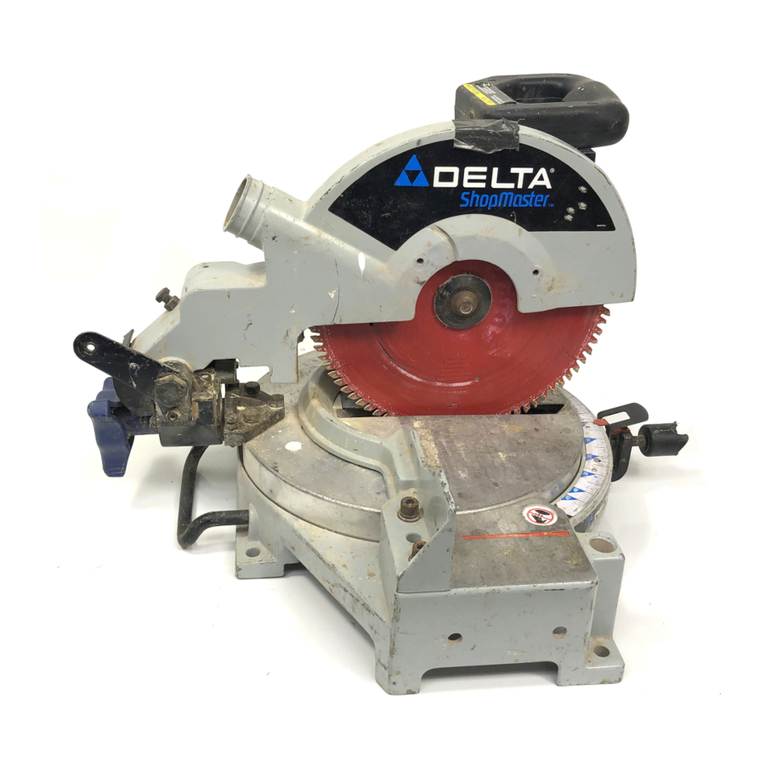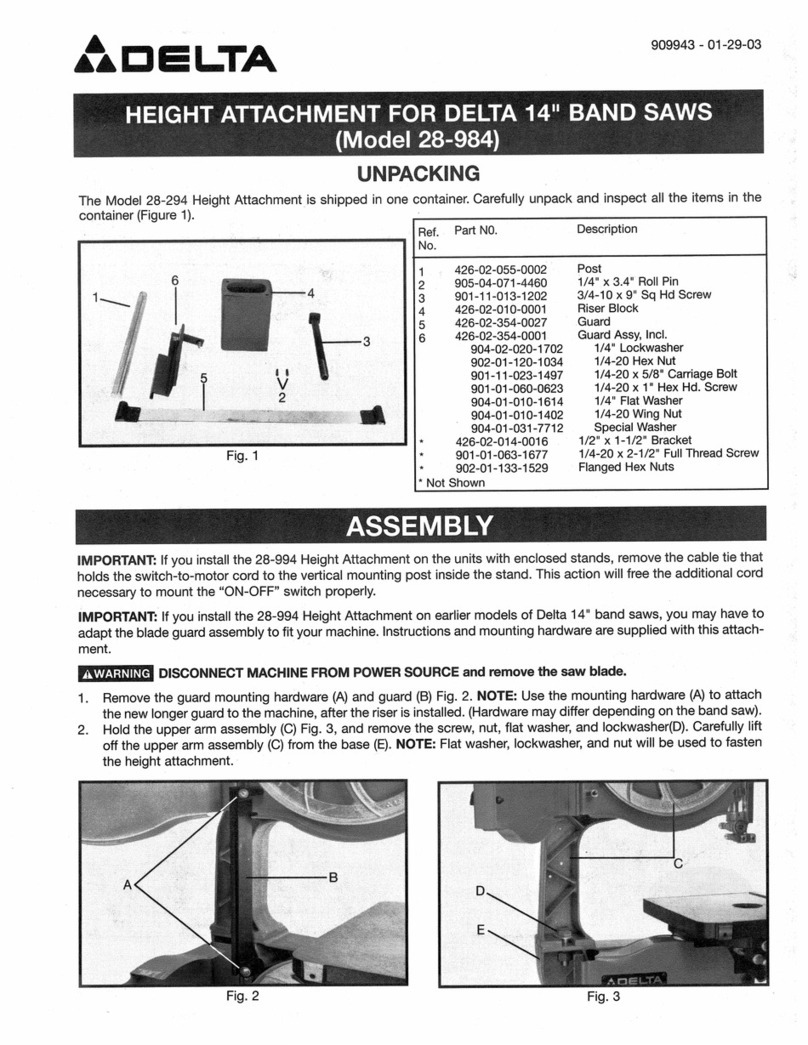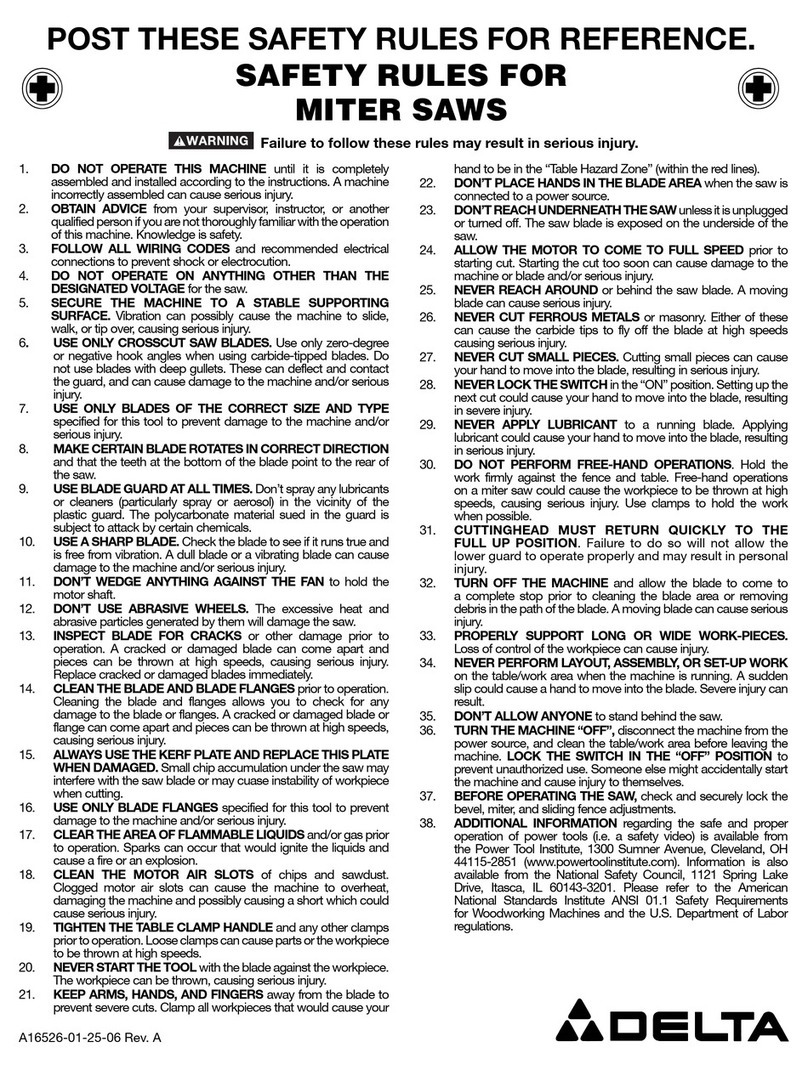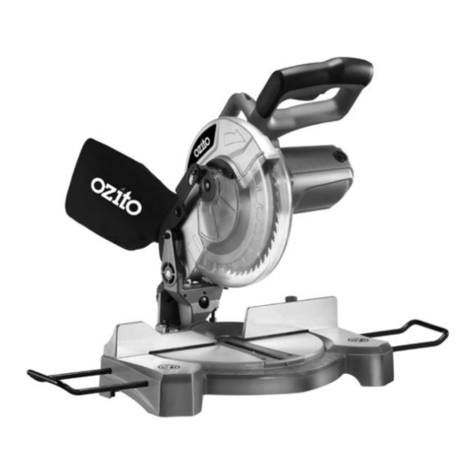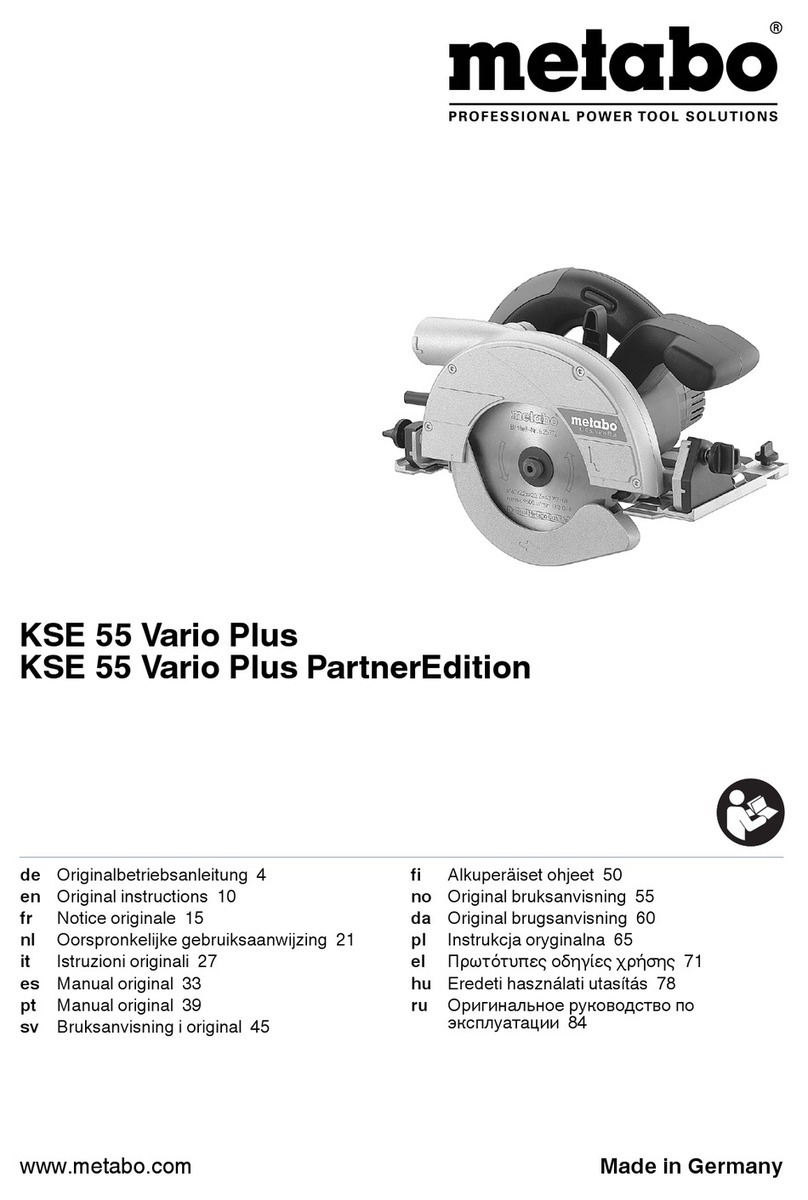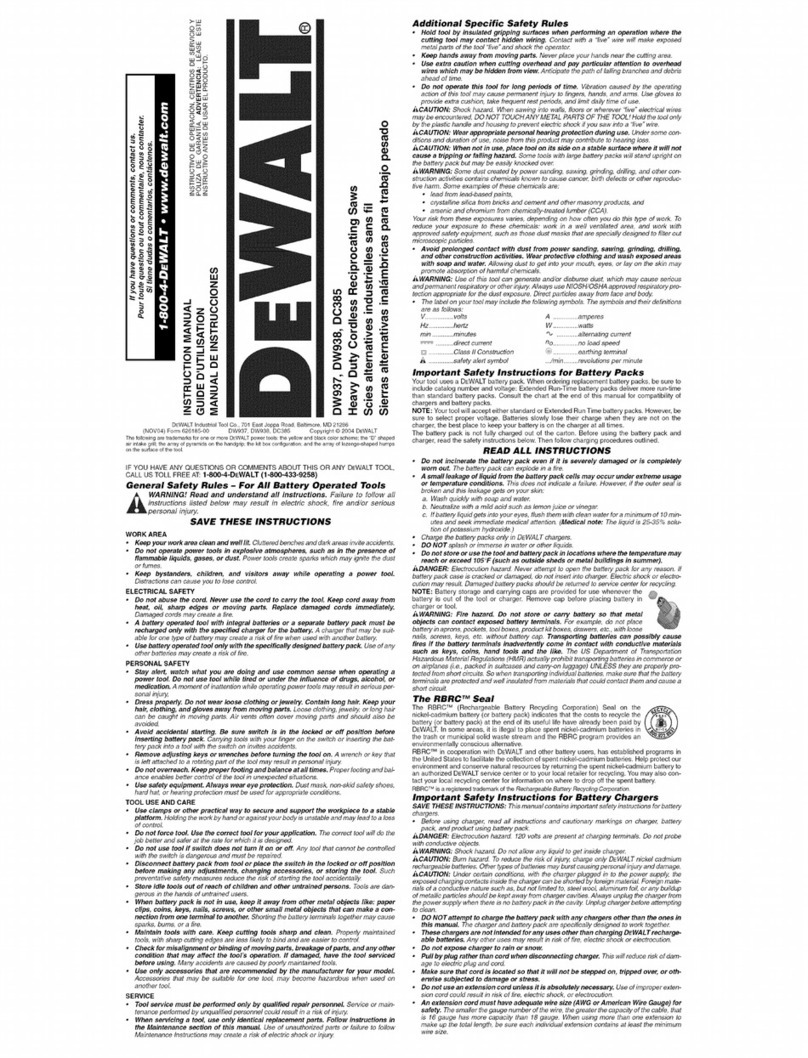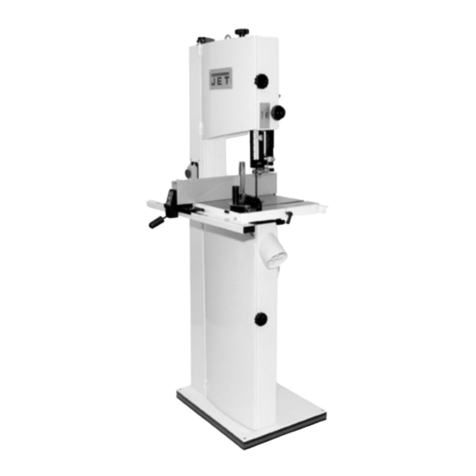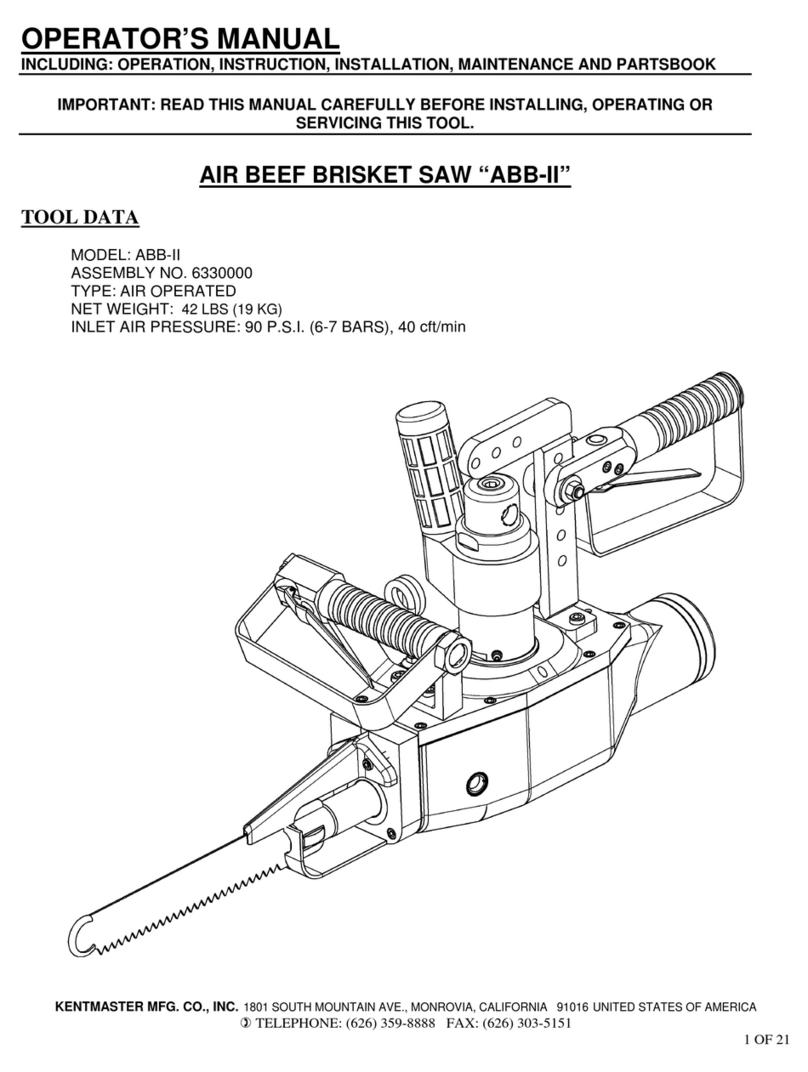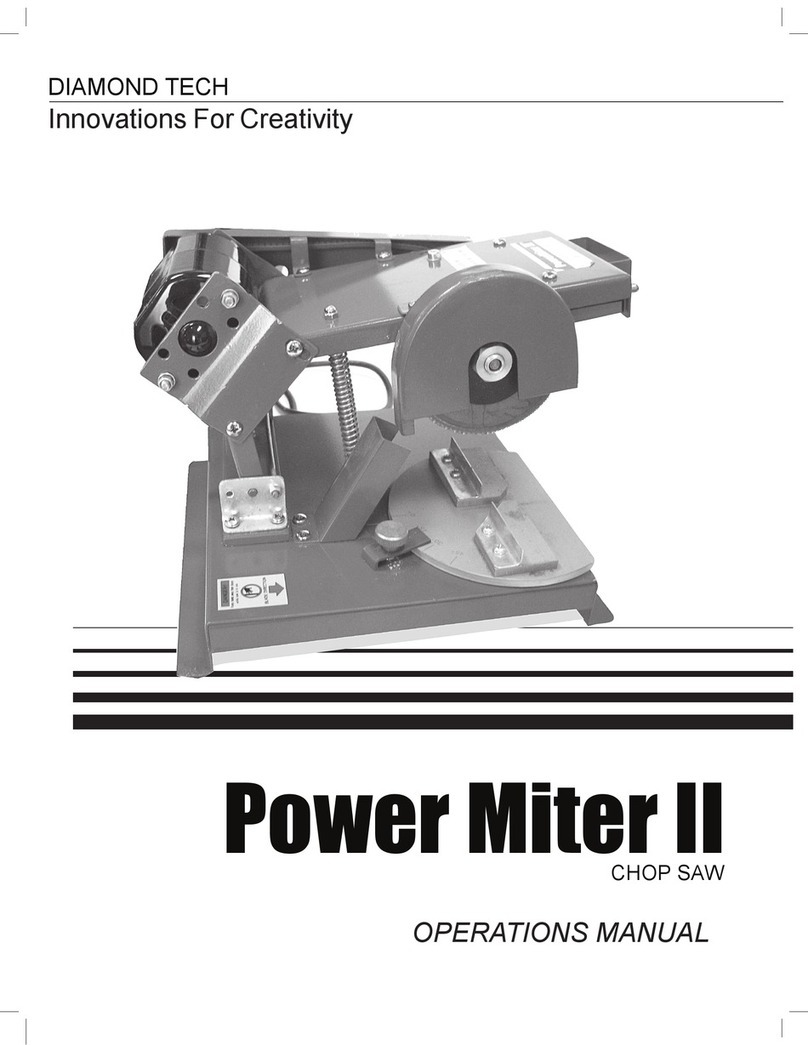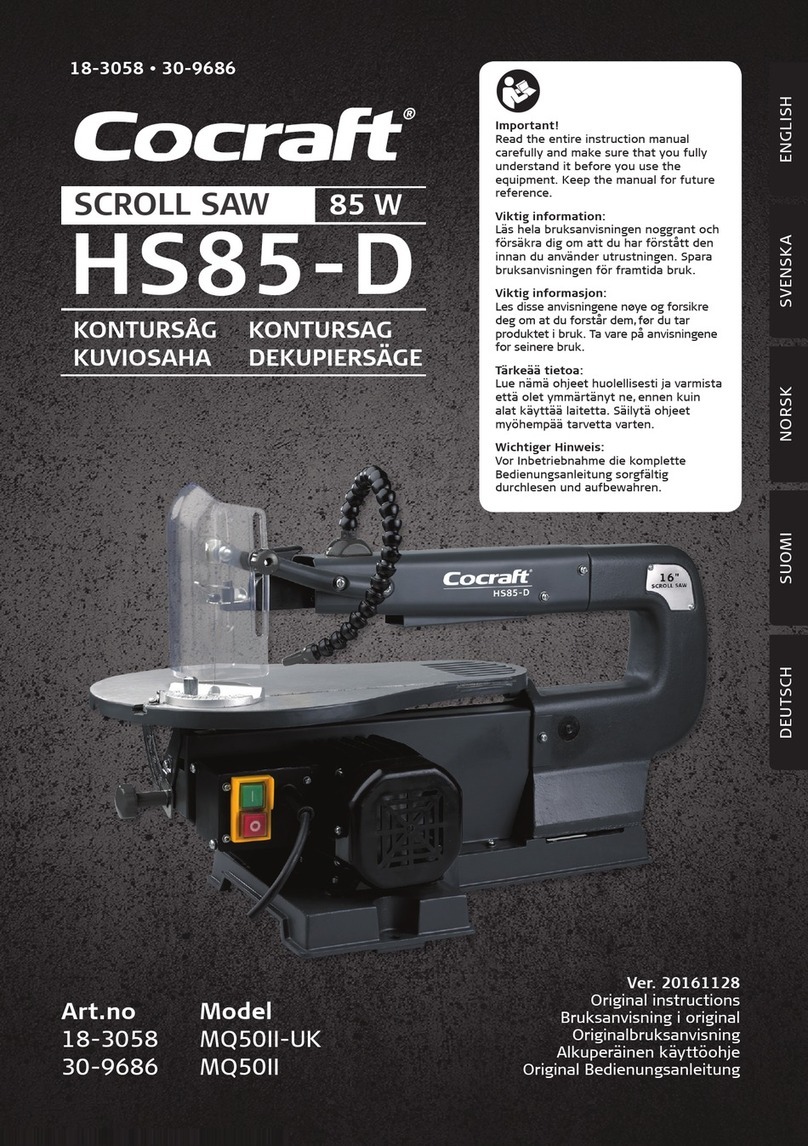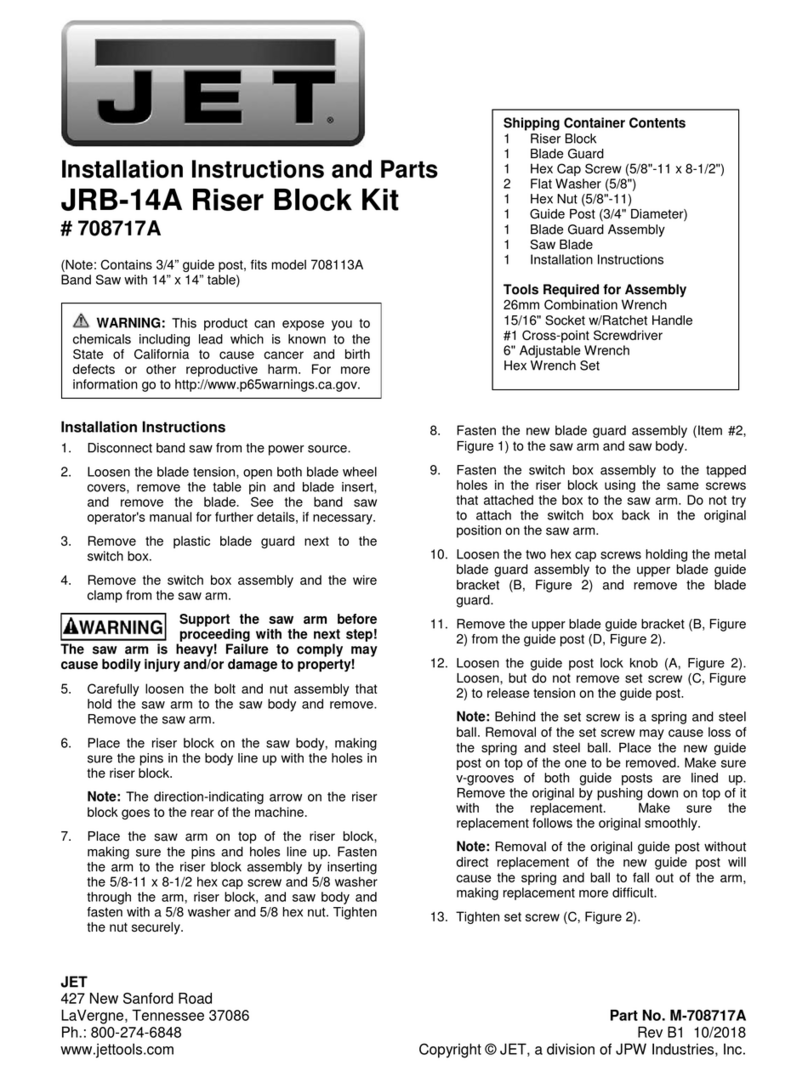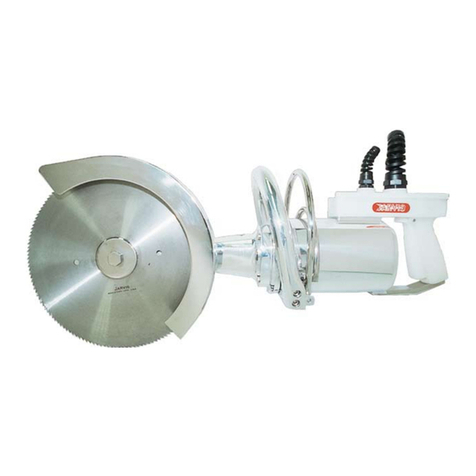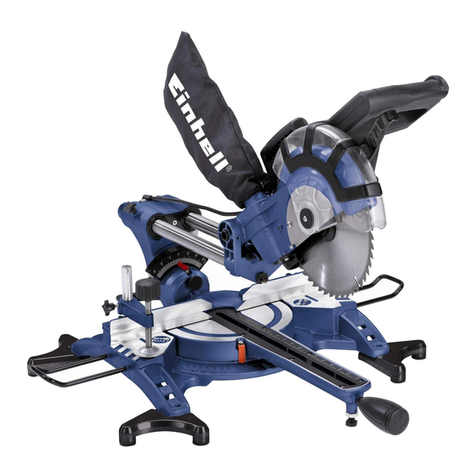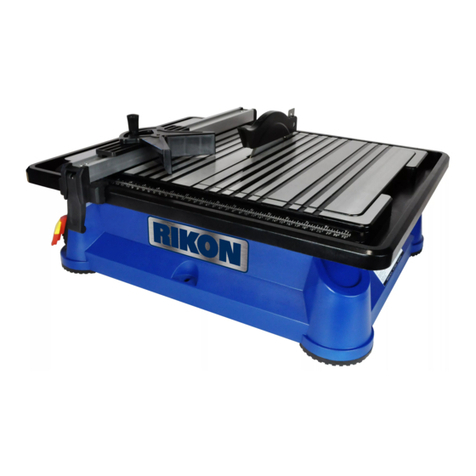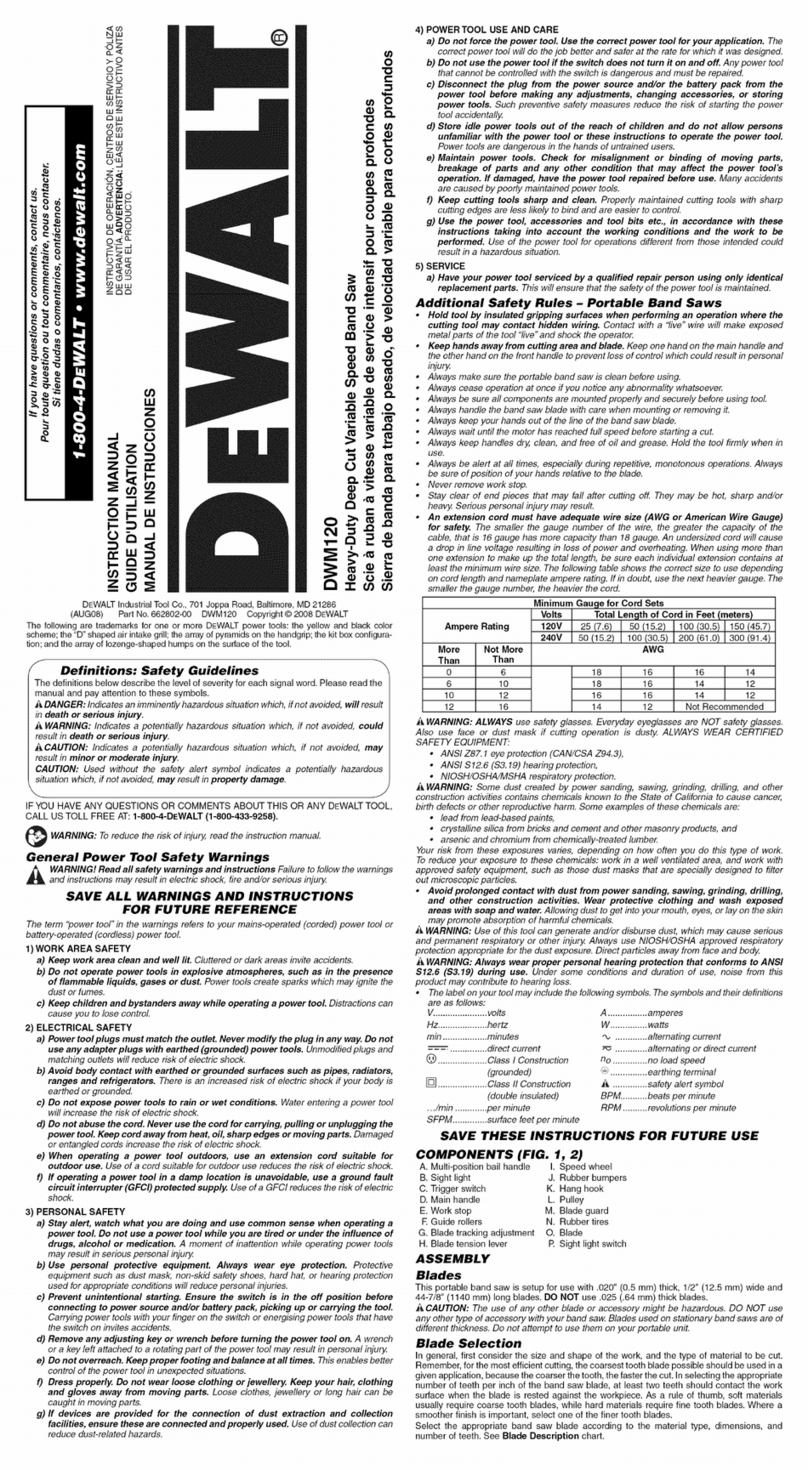Delta 36-444 User manual

INSTRUCTION MANUAL
10″″Contractor’s Saw
(Model 36-444, 36-445)
PART NO. 422-19-651-0048 - 10-18-02
Copyright © 2002 Delta Machinery
To learn more about DELTA MACHINERY
visit our website at: www.deltamachinery.com.
For Parts, Service, Warranty or other Assistance,
please call 1-800-223-7278 (In Canada call 1-800-463-3582).
Shown with Model 36-448
UniRipTM Fence System

2
GENERAL SAFETY RULES
Woodworking can be dangerous if safe and proper operating procedures are not followed. As with all machinery, there
are certain hazards involved with the operation of the product. Using the machine with respect and caution will
considerably lessen the possibility of personal injury. However, if normal safety precautions are overlooked or ignored,
personal injury to the operator may result. Safety equipment such as guards, push sticks, hold-downs, featherboards,
goggles, dust masks and hearing protection can reduce your potential for injury. But even the best guard won’t make
up for poor judgment, carelessness or inattention. Always use common sense and exercise caution in the workshop.
If a procedure feels dangerous, don’t try it. Figure out an alternative procedure that feels safer. REMEMBER: Your
personal safety is your responsibility.
This machine was designed for certain applications only. Delta Machinery strongly recommends that this machine not
be modified and/or used for any application other than that for which it was designed. If you have any questions relative
to a particular application, DO NOT use the machine until you have first contacted Delta to determine if it can or should
be performed on the product.
Technical Service Manager
Delta Machinery
4825 Highway 45 North
Jackson, TN 38305
(IN CANADA: 505 SOUTHGATE DRIVE, GUELPH, ONTARIO N1H 6M7)
WARNING: FAILURE TO FOLLOW THESE RULES MAY RESULT IN SERIOUS PERSONAL INJURY
1. FOR YOUR OWN SAFETY, READ INSTRUCTION
MANUAL BEFORE OPERATING THE TOOL. Learn the
tool’s application and limitations as well as the specific
hazards peculiar to it.
2. KEEP GUARDS IN PLACE and in working order.
3. ALWAYS WEAR EYE PROTECTION.
Wear safety
glasses. Everyday eyeglasses only have impact resistant
lenses; they are not safety glasses. Also use face or dust
mask if cutting operation is dusty. These safety glasses
must conform to ANSI Z87.1 requirements. NOTE:
Approved glasses have Z87 printed or stamped on them.
4. REMOVE ADJUSTING KEYS AND WRENCHES. Form
habit of checking to see that keys and adjusting wrenches
are removed from tool before turning it “on”.
5. KEEP WORK AREA CLEAN. Cluttered areas and
benches invite accidents.
6. DON’T USE IN DANGEROUS ENVIRONMENT. Don’t
use power tools in damp or wet locations, or expose them
to rain. Keep work area well-lighted.
7. KEEP CHILDREN AND VISITORS AWAY. All children
and visitors should be kept a safe distance from work area.
8. MAKE WORKSHOP CHILDPROOF – with padlocks,
master switches, or by removing starter keys.
9. DON’T FORCE TOOL. It will do the job better and be
safer at the rate for which it was designed.
10. USE RIGHT TOOL. Don’t force tool or attachment to
do a job for which it was not designed.
11. WEAR PROPER APPAREL. No loose clothing, gloves,
neckties, rings, bracelets, or other jewelry to get caught in
moving parts. Nonslip footwear is recommended. Wear
protective hair covering to contain long hair.
12. SECURE WORK. Use clamps or a vise to hold work
when practical. It’s safer than using your hand and frees
both hands to operate tool.
13. DON’T OVERREACH. Keep proper footing and
balance at all times.
14. MAINTAIN TOOLS IN TOP CONDITION. Keep tools
sharp and clean for best and safest performance. Follow
instructions for lubricating and changing accessories.
15. DISCONNECT TOOLS before servicing and when
changing accessories such as blades, bits, cutters, etc.
16. USE RECOMMENDED ACCESSORIES. The use of
accessories and attachments not recommended by Delta
may cause hazards or risk of injury to persons.
17. REDUCE THE RISK OF UNINTENTIONAL STARTING.
Make sure switch is in “OFF” position before plugging in
power cord.
In the event of a power failure, move switch
to the “OFF” position.
18. NEVER STAND ON TOOL. Serious injury could occur if
the tool is tipped or if the cutting tool is accidentally
contacted.
19. CHECK DAMAGED PARTS. Before further use of the
tool, a guard or other part that is damaged should be
carefully checked to ensure that it will operate properly and
perform its intended function – check for alignment of
moving parts, binding of moving parts, breakage of parts,
mounting, and any other conditions that may affect its
operation. A guard or other part that is damaged should be
properly repaired or replaced.
20. DIRECTION OF FEED. Feed work into a blade or
cutter against the direction of rotation of the blade or cutter
only.
21. NEVER LEAVE TOOL RUNNING UNATTENDED.
TURN POWER OFF. Don’t leave tool until it comes to a
complete stop.
22.
STAY ALERT, WATCH WHAT YOU ARE DOING, AND
USE COMMON SENSE WHEN OPERATING A POWER
TOOL. DO NOT USE TOOL WHILE TIRED OR UNDER
THE INFLUENCE OF DRUGS, ALCOHOL, OR
MEDICATION. A moment of inattention while operating
power tools may result in serious personal injury.
23. MAKE SURE TOOL IS DISCONNECTED FROM
POWER SUPPLY while motor is being mounted,
connected or reconnected.
24. THE DUST GENERATED by certain woods and wood
products can be injurious to your health. Always operate
machinery in well ventilated areas and provide for proper
dust removal. Use wood dust collection systems whenever
possible.
25.
WARNING: SOME DUST CREATED BY
POWER SANDING, SAWING, GRINDING, DRILLING,
AND OTHER CONSTRUCTION ACTIVITIES contains
chemicals known to cause cancer, birth defects or other
reproductive harm. Some examples of these chemicals
are:
· lead from lead-based paints,
· crystalline silica from bricks and cement and other
masonry products, and
· arsenic and chromium from chemically-treated lumber.
Your risk from these exposures varies, depending on how
often you do this type of work. To reduce your exposure
to these chemicals: work in a well ventilated area, and
work with approved safety equipment, such as those
dust masks that are specially designed to filter out
microscopic particles.
SAVE THESE INSTRUCTIONS.
Refer to them often and use them to instruct others.

3
ADDITIONAL SAFETY RULES FOR
TABLE SAWS
WARNING: FAILURE TO FOLLOW THESE RULES MAY RESULT IN SERIOUS PERSONAL INJURY.
SAVE THESE INSTRUCTIONS.
Refer to them often
and use them to instruct others.
1. DO NOT OPERATE THIS MACHINE until it is
assembled and installed according to the
instructions.
2. OBTAIN ADVICE FROM YOUR SUPERVISOR,
instructor, or another qualified person if you are not
familiar with the operation of this machine.
3. FOLLOW ALL WIRING CODES and recommended
electrical connections.
4. USE THE GUARDS WHENEVER POSSIBLE. Check
to see that they are in place, secured, and working
correctly.
5. AVOID KICKBACK by:
A. keeping blade sharp and free of rust and pitch.
B. keeping rip fence parallel to the saw blade.
C. using saw blade guard and spreader for every
possible operation, including all through sawing.
D. pushing the workpiece past the saw blade prior to
release.
E. never ripping a workpiece that is twisted or
warped, or does not have a straight edge to guide
along the fence.
F. using featherboards when the anti-kickback device
cannot be used.
G. never sawing a large workpiece that cannot be
controlled.
H. never using the fence as a guide when
crosscutting.
I. never sawing a workpiece with loose knots or other
flaws.
6. ALWAYS USE GUARDS, SPLITTER, AND ANTI-
KICKBACK FINGERS except when otherwise directed
in the manual.
7. REMOVE CUT-OFF PIECES AND SCRAPS from the
table before starting the saw. The vibration of the
machine may cause them to move into the saw blade
and be thrown out. After cutting, turn the machine off.
When the blade has come to a complete stop,
remove all debris.
8. NEVER START THE MACHINE with the workpiece
against the blade.
9. HOLD THE WORKPIECE FIRMLY against the miter
gauge or fence.
10. NEVER run the workpiece between the fence and a
moulding cutterhead.
11. NEVER perform “free-hand” operations. Use either the
fence or miter gauge to position and guide the
workpiece.
12. USE PUSH STICK(S) for ripping a narrow workpiece.
13. AVOID AWKWARD OPERATIONS AND HAND
POSITIONS where a sudden slip could cause a hand
to move into the blade.
14. KEEP ARMS, HANDS, AND FINGERS away from the
blade.
15. NEVER have any part of your body in line with the path
of the saw blade.
16. NEVER REACH AROUND or over the saw blade.
17. NEVER attempt to free a stalled saw blade without first
turning the machine “OFF”.
18. PROPERLY SUPPORT LONG OR WIDE workpieces.
19. NEVER PERFORM LAYOUT, assembly or set-up work
on the table/work area when the machine is running.
20. TURN THE MACHINE “OFF” AND DISCONNECT
THE MACHINE from the power source before
installing or removing accessories, before adjusting or
changing set-ups, or when making repairs.
21. TURN THE MACHINE “OFF”, disconnect the machine
from the power source, and clean the table/work area
before leaving the machine. LOCK THE SWITCH IN
THE “OFF” POSITION to prevent unauthorized use.
22. ADDITIONAL INFORMATION regarding the safe and
proper operation of this tool is available from the Power
Tool Institute, 1300 Summer Avenue, Cleveland, OH
44115-2851. Information is also available from the
National Safety Council, 1121 Spring Lake Drive,
Itasca, IL 60143-3201. Please refer to the American
National Standards Institute ANSI 01.1 Safety
Requirements for Woodworking Machines and the U.S.
Department of Labor OSHA 1910.213 Regulations.

4
POWER CONNECTIONS
A separate electrical circuit should be used for your tools. This circuit should not be less than #12 wire and should be
protected with a 15 Amp time lag fuse. If an extension cord is used, use only 3-wire extension cords which have 3-
prong grounding type plugs and matching receptacle which will accept the tool’s plug. Before connecting the motor to
the power line, make sure the switch is in the “OFF” position and be sure that the electric current is of the same
characteristics as indicated on the tool. All line connections should make good contact. Running on low voltage will
damage the motor.
WARNING: DO NOT EXPOSE THE TOOL TO RAIN OR OPERATE THE TOOL IN DAMP LOCATIONS.
GROUNDING INSTRUCTIONS
WARNING: THIS TOOL MUST BE GROUNDED WHILE IN USE TO PROTECT THE OPERATOR FROM
ELECTRIC SHOCK.
Fig. AFig. B
GROUNDED OUTLET BOX
CURRENT
CARRYING
PRONGS
GROUNDING BLADE
IS LONGEST OF THE 3 BLADES
GROUNDED OUTLET BOX
GROUNDING
MEANS
ADAPTER
A temporary adapter, which looks like the adapter
illustrated in Fig. B, may be used to connect this plug to a
matching 2-conductor receptacle as shown in Fig. Bif a
properly grounded outlet is not available. The temporary
adapter should be used only until a properly grounded
outlet can be installed by a qualified electrician. The
green-colored rigid ear, lug, and the like, extending from
the adapter must be connected to a permanent ground
such as a properly grounded outlet box. Whenever the
adapter is used, it must be held in place with a metal
screw.
NOTE: In Canada, the use of a temporary adapter is not
permitted by the Canadian Electric Code.
3. Grounded, cord-connected tools intended for use on
a supply circuit having a nominal rating between 150 -
250 volts, inclusive:
If the tool is intended for use on a circuit that has an
outlet that looks like the one illustrated in Fig. C, the tool
will have a grounding plug that looks like the plug
illustrated in Fig. C. Make sure the tool is connected to
an outlet having the same configuration as the plug. No
adapter is available or should be used with this tool. If
the tool must be re-connected for use on a different type
of electric circuit, the re-connection should be made by
qualified service personnel; and after re-connection, the
tool should comply with all local codes and ordinances.
WARNING: IN ALL CASES, MAKE CERTAIN THE
RECEPTACLE IN QUESTION IS PROPERLY
GROUNDED. IF YOU ARE NOT SURE HAVE A
QUALIFIED ELECTRICIAN CHECK THE RECEPTACLE.
1. All grounded, cord-connected tools:
In the event of a malfunction or breakdown, grounding
provides a path of least resistance for electric current to
reduce the risk of electric shock. This tool is equipped with
an electric cord having an equipment-grounding
conductor and a grounding plug. The plug must be
plugged into a matching outlet that is properly installed
and grounded in accordance with all local codes and
ordinances.
Do not modify the plug provided - if it will not fit the outlet,
have the proper outlet installed by a qualified electrician.
Improper connection of the equipment-grounding
conductor can result in risk of electric shock. The
conductor with insulation having an outer surface that is
green with or without yellow stripes is the equipment-
grounding conductor. If repair or replacement of the
electric cord or plug is necessary, do not connect the
equipment-grounding conductor to a live terminal.
Check with a qualified electrician or service personnel if
the grounding instructions are not completely understood,
or if in doubt as to whether the tool is properly grounded.
Use only 3-wire extension cords that have 3-prong
grounding type plugs and matching 3-conductor
receptacles that accept the tool’s plug, as shown in Fig. A.
Repair or replace damaged or worn cord immediately.
2. Grounded, cord-connected tools intended for use on
a supply circuit having a nominal rating less than 150
volts:
If the tool is intended for use on a circuit that has an outlet
that looks like the one illustrated in Fig. A, the tool will have
a grounding plug that looks like the plug illustrated in Fig.
A.

5
Use proper extension cords. Make sure your extension
cord is in good condition and is a 3-wire extension cord
which has a 3-prong grounding type plug and matching
receptacle which will accept the tool’s plug. When using
an extension cord, be sure to use one heavy enough to
carry the current of the tool. An undersized cord will
cause a drop in line voltage, resulting in loss of power
and overheating. Fig. D, shows the correct gauge to use
depending on the cord length. If in doubt, use the next
heavier gauge. The smaller the gauge number, the
heavier the cord.
EXTENSION CORDS
FUNCTIONAL DESCRIPTION
FOREWORD
Delta Model 36-444/445 is a 10″Contractor’s SawTM designed to give high quality performance with maximum depth of
cut 3-1/8″ (79mm)at 90° and 2-1/8″(54mm) at 45° for clean cutting of standard stock sizes. Delta Model 36-444/445
includes; basic machine, sturdy steel stand, integral dust chute, UniRipTM T-SquareTM -style fence system on Model 36-
444 or UnifenceTM Fence System on Model 36-445, patented Auto-SetTM T-Slot miter gage, heavy duty motor, on/off
paddle switch, cast iron table, table extension wings, see-thru blade guard with splitter and anti-kickback attachment,
convenient up-front blade raising and tilting controls and 10″blade.
Fig. DFig. D
MINIMUM GAUGE EXTENSION CORD
RECOMMENDED SIZES FOR USE WITH STATIONARY ELECTRIC TOOLS
Ampere Total Length Gauge of
Rating Volts of Cord in Feet Extension Cord
0-6 120
up to
25 18 AWG
0-6 120 25-50 16 AWG
0-6 120 50-100 16 AWG
0-6 120 100-150 14 AWG
6-10 120
up to
25 18 AWG
6-10 120 25-50 16 AWG
6-10 120 50-100 14 AWG
6-10 120 100-150 12 AWG
10-12 120
up to
25 16 AWG
10-12 120 25-50 16 AWG
10-12 120 50-100 14 AWG
10-12 120 100-150 12 AWG
12-16 120
up to
25 14 AWG
12-16 120 25-50 12 AWG
12-16 120 GREATER THAN 50 FEET NOT RECOMMENDED
MINIMUM GAUGE EXTENSION CORD
RECOMMENDED SIZES FOR USE WITH STATIONARY ELECTRIC TOOLS
Ampere Total Length Gauge of
Rating Volts of Cord in Feet Extension Cord
0-6 240
up to
50 18 AWG
0-6 240 50-100 16 AWG
0-6 240 100-200 16 AWG
0-6 240 200-300 14 AWG
6-10 240
up to
50 18 AWG
6-10 240 50-100 16 AWG
6-10 240 100-200 14 AWG
6-10 240 200-300 12 AWG
10-12 240
up to
50 16 AWG
10-12 240 50-100 16 AWG
10-12 240 100-200 14 AWG
10-12 240 200-300 12 AWG
12-16 240
up to
50 14 AWG
12-16 240 50-100 12 AWG
12-16 240
GREATER THAN 100 FEET NOT RECOMMENDED
GROUNDED OUTLET BOX
CURRENT CARRYING PRONGS
GROUNDING BLADE
IS LONGEST OF THE 3 BLADES
Fig. C

6
UNPACKING AND CLEANING
Carefully unpack the machine and all loose items from the shipping container(s). Remove the protective coating from the
machined surfaces of the saw. This coating may be removed with a soft cloth moistened with kerosene (do not use
acetone, gasoline or lacquer thinner for this purpose). After cleaning, cover the unpainted surfaces with a good quality
household floor paste wax. Fig. 2, illustrates the components of the table saw. Fig. 3, illustrates the components of the
saw stand. NOTE: The fence system components will be illustrated in the particular instruction manual for that product.
1. Contractor’s Saw
2. Blade Tilting Handwheel
3. Handwheel Lock Knob
4. Blade Guard and Splitter Assembly
5. Table Insert
6. Miter Gage
Fig. 2
7. Miter Gage Handle Hardware:
8. Splitter Mounting Bracket
9. Hardware (2)
10. Arbor Wrenches (2)
11. Extension Wing
11
10
8
7
9
6
5
3
2
4
1

7
Fig. 3
1
2
3
4
5
6
7
8
9
10
1. Combination Dust Chute/
Support Panel
2. Motor Pulley
3. Motor
4. Pulley Guard
5. Drive Belt
6. Motor Mounting Plate
7. Rear Leg Panel
8. Hardware
9. Rubber Feet (4)
10. Front Leg Panel

8
ASSEMBLY INSTRUCTIONS
WARNING: MAKE SURE THE SAW IS SECURELY ATTACHED TO THE STAND BEFORE PERFORMING ANY
CUTTING OPERATIONS. DO NOT OPERATE THIS MACHINE UNTIL YOU READ AND UNDERSTAND THE
ENTIRE INSTRUCTION MANUAL.
Fig. 5
Fig. 6
Fig. 7
ASSEMBLING SAW STAND
1. Assemble the dust chute and support panel (A)
Fig. 5, to the inside of the front stand panel (B) with three
#10 x 1/2″sheet metal screws (C).
2. Insert four #10-32 x 1/2″screws (D) Fig. 6 through
support panel and dust chute. Install four #10-32 hex
nuts (E) Fig. 6. NOTE: The front stand panel will have the
saw identity labels facing you. Do not completely tighten
the stand hardware at this time. Also, make certain the
dust chute/support panel (A) Fig. 6, is located under the
lip of front stand panel (B).
3. Assemble the other end of dust chute and support
panel (A) Fig. 7, to rear stand panel (F) as shown with
four #10-32 x 1/2″screws and #10-32 hex nuts, which
are shown at (C). NOTE: Do not completely tighten stand
hardware at this time.
B
A
A
B
A
C
C
F
Fig. 8
ASSEMBLING
SAW TO STAND
1. Turn saw table face down. Place stand (B) Fig. 8,
onto saw (A). Align eight holes in the stand (B) with
mounting holes in the saw (A) and fasten with eight 5/16"-
18 screws, flat washers, lockwashers, and hex nuts one
of which is shown at (C) Fig. 8. Assemble flat washers
onto screws, place screws through holes, assemble
lockwashers then hex nuts finger tight. Do not
completely tighten hardware at this time.
2. Install four rubber feet (D) Fig. 8, on the end of each
stand leg (B).
3. Turn saw table face up.
C
A
B
C
C
ED
D

9
Fig. 9
Fig. 10
Fig. 11
ASSEMBLING BLADE
TILTING HANDWHEEL
1. Assemble blade tilting handwheel (A) Fig. 10, to
shaft (B). Make certain slot (C) in handwheel is engaged
with roll pin (D) on the shaft.
2. Thread locking lever (E) Fig. 11, into end of shaft (B).
3. Fig. 11, illustrates the blade tilting handwheel (A)
and locking lever (E) assembled to the saw.
E
F
G
D
B
AC
A
E
4. Push down on the top of the saw (E) Fig. 9 until the
stand legs (F) are positioned firmly on the floor surface.
Securely tighten all saw and stand mounting hardware.
Note that panel (G) is not only a support for a stand, but
also serves as a dust chute.
5. Fig. 9, illustrates the saw assembled to the stand.
NOTE: If it becomes necessary to move the saw to
another location, additional adjustments may be
required.

10
MOTOR
The motor supplied with your saw is a 1-1/2 H.P. at 115 volts or 2 H.P. at 230 volts, Ball Bearing,
Capacitor Start/Capacitor Run, motor. This motor has been specially selected to best power your
machine and the relative safety of the machine is enhanced by its use. We, therefore, strongly suggest
that only this motor be used, as the use of other motors may be detrimental to the performance and
safety of the saw.
Fig. 12
ASSEMBLING MOTOR TO
MOTOR MOUNTING PLATE
WARNING: DISCONNECT MACHINE FROM
POWER SOURCE.
1. Assemble the motor (A) to the motor mounting plate
(B) as shown in Fig. 12, using four 5/16″carriage bolts,
flat washers, star washers, and hex nuts (C)]. Assemble
bolts through holes, assemble flat washers, star
washers and hex nuts.
NOTE: Do not completely tighten hardware at this time.
A
C
B
Fig. 13
Fig. 15
Fig. 14
ASSEMBLING MOTOR
AND MOTOR MOUNTING
PLATE TO SAW
WARNING: DISCONNECT MACHINE FROM
POWER SOURCE.
1. Position motor and motor mounting plate (A) Fig. 13,
below bracket (B) to allow bracket arm to slide through
large opening in motor mounting plate (A).
2. Depress one plunger (C) Fig. 14 and connect one
side of motor mounting plate (A) to bracket (B). Then
depress other plunger (C) and rotate motor mounting
plate (A) until both plungers are engaged in holes (D) Fig.
13.
3. Fig. 15, illustrates the motor and motor mounting
plate assembled to the rear of the saw.
B
D
A
C
B
C
A

11
Fig. 16
Fig. 17
ASSEMBLING MOTOR
PULLEY, BELT AND
PULLEY GUARD, AND
DRIVE BELT
WARNING: DISCONNECT MACHINE FROM
POWER SOURCE.
1. Remove the motor shaft key that is taped to the
motor.
2. Insert the key (A) Fig. 16, in the keyway on the motor
shaft. Assemble the motor pulley (B) on the motor shaft
as shown, with the hub of the pulley out. Loosely tighten
set screw (C) against key (A) in motor shaft.
3. Remove wing nut and external tooth lockwasher (D)
Fig. 17, and outer cover (E) from belt and pulley guard (G).
B
A
C
GD
E
Fig. 18
Fig. 19
4. Slide the belt and pulley guard bracket (G) Fig. 18,
between the motor base plate (M) and motor mounting
plate(L), as shown. Do not completely tighten the four
hex nuts that fasten the motor to the motor mounting
plate at this time.
5. Position belt and pulley guard bracket (G) Fig. 19, so
the motor pulley (B) is centered and through the hole in
the belt and pulley guard bracket, as shown.
6. Using a straight edge (A) Fig. 19 align the motor
pulley (B) with the arbor pulley(C). Tighten the motor
pulley set screw and the four hex nuts that fasten the
motor to the motor mounting plate.
7. Lift up on the motor and assemble the drive belt (H)
Fig. 20, to the arbor pulley and motor pulley (B). The
weight of the motor will provide the correct belt tension. M
L
G
G
B
Fig. 20
H
B
A
C

12
Fig. 21
WARNING: IMMEDIATELY AFTER ASSEMBLING
THE BELT, RAISE THE SAW BLADE TO ITS MAXIMUM
HEIGHT AND TILT THE SAW BLADE TO 45 DEGREES.
CHECK TO SEE IF THE MOTOR END BELL (J) FIG. 21,
IS BELOW THE TOP OF THE TABLE SURFACE (K). IF
THE MOTOR END BELL (J) IS ABOVE THE TOP OF
THE TABLE SURFACE, THE MOTOR MUST BE MOVED
TO THE LEFT UNTIL YOU ARE CERTAIN THE END
BELL (J) OF THE MOTOR IS BELOW THE TOP OF
THE TABLE SURFACE. THEN RE-ALIGN THE MOTOR
PULLEY TO THE ARBOR PULLEY.
K
J
Fig. 22
8. Assemble the outer cover (E) Fig. 22, of the belt and
pulley guard assembly, which was removed in STEP 3,
and fasten with external tooth lockwasher and wing nut
(D). IMPORTANT: Make certain the outer cover does not
interfere with the drive belt and the motor pulley.
DE
Fig. 23
CONNECTING MOTOR CORD
TO SWITCH ASSEMBLY
WARNING: DISCONNECT MACHINE FROM
POWER SOURCE.
1. Insert the pronged motor plug (A) Fig. 23, into the
female receptacle (B) of switch-to-motor cord (C).
2. The motor cord connected to the switch assembly
is shown at (A) Fig. 24.
C
B
A
Fig. 24
OVERLOAD PROTECTION
The motor for use with your saw is equipped with a reset
overload relay button (B) Fig. 24. If the motor shuts off or
fails to start due to overloading (cutting stock too fast,
using a dull blade, using the saw beyond its capacity,
etc.), or low voltage, move the switch to the “OFF”
position, let the motor cool three to five
minutes and push the reset button (B), which will reset
the overload device.The motor can then be turned on
again in the usual manner.
B
A

13
REPOSITIONING MOTOR FOR STORAGE
When the saw is not in use, the motor can be repositioned so it hangs straight down at the
rear, enabling you to move the saw closer to the wall. This can be accomplished by
removing the belt from the arbor pulley and repositioning the motor and motor mounting
plate, as shown in Fig. 25.
Fig. 25
Fig. 26
Fig. 27
ASSEMBLING
BLADE GUARD AND
SPLITTER ASSEMBLY
WARNING: DISCONNECT MACHINE FROM
POWER SOURCE.
1. Fasten the rear splitter mounting bracket (A) Fig. 26,
to the rear trunnion using the two 1/4-20 x 3/4"- hex
head screws (B) and flat washers. Do not completely
tighten the two screws (B) at this time.
2. With two 7/8″ wrenches supplied, remove the saw
blade from the saw. Raise saw arbor to its highest
position.
3. Remove screw and large washer (C) Fig. 27, from
the inside splitter mounting bracket.
BA
C

14
Fig. 28
D
E
Fig. 29
Fig. 30
4. Using a straight edge, check to see if the top and
bottom of the inside splitter bracket (D) Fig. 28, is
aligned with the inner arbor flange (E), as shown.
5. When alignment is necessary, loosen the two
screws (F) Fig. 29, align bracket (D) with the arbor
flange and tighten screws (F).
6. Loosely assemble large washer and screw (C) Fig. 29,
to the inside splitter bracket. This screw and washer was
removed in STEP 3.
7. Assemble the blade guard and splitter assembly (G)
Fig. 30, between the large washer (C) and the splitter
bracket and tighten screw (H) with wrench supplied.
C
D
F
G
H
C
Fig. 32
G
L
M
Fig. 33
L
K
Fig. 31
GL
J
8. Fasten the rear of the blade guard and splitter bracket
assembly (G) Fig. 31, to the rear splitter mounting
bracket using 5/16-18 x 5/8" carriage bolt (J) , flat
washer, and hex nut. Assemble carriage bolt through
hole, add flat washer then hex nut and tighten.
IMPORTANT: The splitter (G) Fig. 31, has a notch (L) cut
in the top edge as shown. This feature will enable the
blade guard to stay in the raised position to make blade
changing easier. Raise the front of blade guard (M) Fig.
32, until the rear edge of the blade guard slips into notch
(L) of splitter (G); the blade guard will stay in this
position.
9. With the blade guard (L) Fig. 33, in the raised
position, assemble the saw blade as shown at (K) on the
saw arbor (M) and tighten arbor nut (N) with two 7/8"
arbor wrenches supplied.
M
N

15
Fig. 34
Fig. 35
G
G
A
Fig. 36
10. Using a straight edge, check to see if the saw blade
is aligned with the rear of the splitter (G), as shown in
Figs. 34 and 35. If alignment is necessary, loosen the
two splitter mounting screws located at (A), align splitter
(G) with the saw blade, and tighten two screws (A).
11. Lower saw blade and install table insert (P) Fig. 36,
in the saw table as shown. IMPORTANT: When installing
the table insert, always make certain to hold on to the
blade guard (L). The insert will automatically release the
holding action on the splitter and lower the blade guard
when it is installed in the table opening.
NOTE: Table insert adjustment is described later in
ADJUSTING TABLE INSERT.
L
P
Fig. 37
Fig. 38
ASSEMBLING
EXTENSION WING
1. Assemble extension wing (A) Fig. 37, to the saw
table using three 7/16-20 x 3/4″screws (B) and flat
washers (C) only one of each is shown.
2. With a straight edge (D) Fig. 37, make certain the
extension wing (A) is level with the saw table before
tightening three screws (B).
ASSEMBLING SWITCH
ASSEMBLY
1. Assemble switch bracket (A) Fig. 38, to the front of
extension wing (B) and fasten with 3/8-16 x 1″long
carriage head bolt, flat washer, and hex nut (C). Note:
When installing the UniRip Fence, this bolt must be
loosened.
NOTE: Model 36-445 with the Unifence is assembled
the same way, but requires different hardware.
D
C
B
A
C
B
A

16
FASTENING STAND TO SUPPORTING SURFACE
WARNING: IF DURING OPERATION THERE IS ANY TENDENCY FOR THE SAW TO TIP OVER, SLIDE OR
WALK ON THE SUPPORTING SURFACE, THE SAW STAND SHOULD BE SECURED TO THE FLOOR
SURFACE. THE RUBBER FEET OF THE STAND FEATURE HOLES WHICH ALLOW EASY MOUNTING
WITHOUT REMOVING THE SAW FROM THE STAND.
OPERATING CONTROLS AND ADJUSTMENTS
Fig. 39
Fig. 40
A
B
A
Fig. 41
LOCKING SWITCH IN
THE “OFF” POSITION
IMPORTANT: When the machine is not in use, the
switch should be locked in the “OFF” position to
prevent unauthorized use, using a padlock (C) Fig. 41
with a 3/16" diameter shackle.
C
STARTING AND STOPPING SAW
1. The on/off switch is located underneath the switch
shield (A) Fig. 39. To turn the saw “ON,” move switch
trigger (B) to the up position.
2. To turn the saw “OFF,” push down on switch shield
(A) Fig. 40.

17
Fig. 42
Fig. 43
RAISING AND LOWERING
THE BLADE
To raise the saw blade, loosen lock knob (A) Fig. 42, and
turn the blade raising handwheel (B) clockwise. When
the blade is at the desired height, tighten lock knob (A).
To lower the blade, loosen lock knob (A) Fig. 42, and turn
the handwheel (B) counterclockwise. When the blade is
at the desired height, tighten lock knob (A). NOTE: One
full turn of the handwheel will change blade height
approximately 1/4".
TILTING THE BLADE
To tilt the saw blade for bevel cutting, loosen lock knob
(C) Fig. 42, and turn the tilting handwheel (D). When the
desired blade angle is obtained, tighten lock knob (C).
ADJUSTING 90 DEGREE AND
45 DEGREE POSITIVE STOPS
Your saw is equipped with positive stops that will quickly
and accurately position the saw blade at 90 degrees and
45 degrees to the table. To check and adjust the positive
stops, proceed as follows:
WARNING: DISCONNECT MACHINE FROM
POWER SOURCE.
1. Raise the saw blade to its highest position.
2. Set the blade at 90 degrees to the table by turning
the blade tilting handwheel counterclockwise as far as it
will go.
3. Using a combination square (A) Fig. 43, check to
see if the blade is at 90 degrees to the table surface as
shown.
4. If the blade is not at 90 degrees to the table, loosen
set screw (B) Fig. 43 with allen wrench (C), and turn the
blade tilting handwheel until you are certain the blade is
at 90 degrees to the table. Turn set screw (B) clockwise
until it bottoms.
5. Adjust the pointer (D) Fig. 44, to point to the zero
degree mark on the scale by loosening screw (E),
adjusting pointer (D), and tightening screw (E).
6. Turn the blade tilting handwheel clockwise as far as
it will go and using a combination square, check to see
if the blade is at 45 degrees to the table.
7. If the blade is not at 45 degrees to the table, loosen
set screw (F) Fig. 43, and turn blade tilting handwheel
until you are certain the blade is 45 degrees to the table.
Turn set screw (F) clockwise until it bottoms.
BA
D
C
C
B
F
A
Fig. 44
ED

18
BACKLASH ADJUSTMENTS
FOR BLADE RAISING AND
BLADE TILTING
MECHANISMS
If any play is detected in the blade raising or blade tilting
mechanisms, the following adjustments should be
made.
WARNING: DISCONNECT MACHINE FROM
POWER SOURCE.
1. NOTE: The machine has been turned upside down
and the blade removed for clarity and safety.
2. Adjusting blade raising mechanism - Loosen
locknut (A) Fig. 45, and turn eccentric sleeve (B) until all
play is removed in mechanism and tighten locknut (A).
3. Adjusting blade tilting mechanism - Loosen
locknut (C) Fig. 45, and turn eccentric (D) until all play is
removed in mechanism and tighten locknut (C).
Fig. 45
Fig. 46
Fig. 47
Fig. 48
RIP FENCE OPERATION
AND ADJUSTMENTS
The rip fence can be used on either side of the saw
blade. The most common location is on the right side
and is guided by means of guide rails which are fastened
to the front and rear of the table.
1. To move the rip fence, raise the lock handle (A) Fig.
46, as far as it will go and move the fence to the desired
position on the table. When the lock handle (A) Fig. 46,
is pushed down, clamping action on the rip fence (B)
should be adequate. However, if the clamping action is
too loose or too tight, an adjustment can be made by
equally tightening or loosening two screws (C) as
necessary. NOTE: It will be necessary to remove the
cursor (D) Fig. 48, to make this adjustment
IMPORTANT: THE BLADE FLANGE IS SET PARALLEL
TO THE MITER GAGE SLOT AT THE FACTORY AND
THE RIP FENCE MUST BE PROPERLY ALIGNED TO
THE MITER GAGE SLOT IN ORDER TO PREVENT
“KICKBACK” WHEN RIPPING.
2. Position the fence (B) Fig. 46, along one edge of the
miter gage slot (F) as shown and lock the fence in that
position. The edge of the fence (B) Fig. 46, should line
up parallel to the miter gage slot (F). If an adjustment is
necessary, proceed as follows:
3. Tighten or loosen either of two screws (C) Fig. 46, as
necessary, until the fence (B) is parallel to the miter gage
slot. NOTE: It will be necessary to remove the cursor (D)
Fig. 48, to make this adjustment. Readjust the clamping
action on the fence; if necessary, refer to STEP 1. Re-
assemble the cursor.
IMPORTANT: THE RIP FENCE MUST BE
PERPENDICULAR TO AND LEVEL WITH THE SAW
TABLE.
4. Using a square (G) Fig. 47, and a straight edge (H),
check to see if the rip fence (B) is perpendicular to the
saw table and that the rip fence body is level with the
saw table. If an adjustment is necessary, tighten or
loosen either of two screws (K), until the fence is
perpendicular and level with the saw table.
E
D
E
C
F
C
B
A
G
B
K
K
H
A
B
D
C

19
Fig. 49
Fig. 50
Fig. 51
Fig. 52
ADJUSTING TABLE INSERT
WARNING: DISCONNECT MACHINE FROM
POWER SOURCE.
Place a straight edge across the table at both ends of
the table insert as shown in Fig. 52. The table insert (A)
should always be level with the table. If an adjustment is
necessary, turn the adjusting screws (B), as needed.
Four adjusting screws (B) are supplied in the table insert.
The table insert is equipped with a convenient finger
hole (C) for easy removal.
K
A
A
B
D
B
C
B
A
C
B
MITER GAGE OPERATION
AND ADJUSTMENT
Insert the miter gage bar into the miter gage slot and
assemble the washer and lock handle (A) Fig. 49, to
the miter gage bar as shown. Insert cap (K) into top of
handle (A).
The miter gage is equipped with adjustable index stops
at 90 degrees and 45 degrees right and left. Adjustment
to the index stops can be made by tightening or
loosening the three adjusting screws (B) Fig. 50.
To rotate the miter gage, loosen lock knob (A) Fig. 50,
and move the body of the miter gage (C) to the desired
angle.
The miter gage body will stop at 90 degrees and 45
degrees both right and left. To rotate the miter gage
body past these points, the stop link (D) Fig. 50, must be
moved up and out of the way.
The miter gage is equipped with a special washer (E)
Fig. 51, and flat head screw (F), which are to be
assembled to the end of the miter gage bar.
The head of the miter gage pivots on a special tapered
screw (G) that fastens the head to the miter gage bar.
If the miter gage head does not pivot freely, or pivots
too freely, it can be adjusted by loosening set screw (H)
Fig. 51, and turning the screw (G), in or out. Be certain
to tighten screw (H) after adjustment is made.
5. Depending on the type of saw blade being used, the
cursor (D) Fig. 48, may need adjustment to compensate
for the blade thickness.To adjust the cursor, make a test
cut on a piece of lumber and measure the finished cut,
or you can place the rip fence against the blade as
shown earlier in the manual. If a minor adjustment is
necessary, loosen two screws (E) Fig. 48, and move the
cursor (D) as necessary.

20
Fig. 53
Fig. 54
Fig. 55
Fig. 56
CHANGING THE
SAW BLADE
WARNING: DISCONNECT MACHINE FROM
POWER SOURCE.
1. NOTE: Two 7/8″wrenches are supplied with the saw
for changing the saw blade: a box end wrench (A) Fig. 53,
and open end wrench (B).
2. Remove table insert (C) Fig. 53, and raise saw blade
to its maximum height.
3. Place the open end wrench (B) Fig. 54, on the flats of
the saw arbor to keep the arbor from turning, and using
wrench (A), turn the arbor nut toward the front of the saw.
Remove arbor nut, blade flange, and saw blade.
4. Assemble the new blade, making certain the teeth
point down at the front of the saw table, and assemble
outside blade flange and arbor nut. With wrench (B)
Fig. 54, on the flats of the arbor to keep it from turning,
tighten arbor nut by turning wrench (A) counterclockwise.
5. Replace table insert.
STORING THE MITER GAGE,
RIP FENCE, AND ARBOR
WRENCHES
1. When not in use, the miter gage (A) Fig. 55, can be
stored through the hole located at the front side of the
stand as shown.
2. The rip fence (B) Fig. 55, can be stored out-of-the-
way on the stamped ledges on the right side of the saw
stand.
3. Arbor wrenches (C) Fig. 56, can be stored on one of
the two notched legs.
DUST CHUTE
The saw stand support panel (D) Fig. 56, also serves as
a natural built-in dust chute. This dust chute (D) allows
the sawdust to escape out of the rear of the saw stand
and away from the work area.
A
B
C
A
B
DC
A
B
This manual suits for next models
1
Table of contents
Other Delta Saw manuals
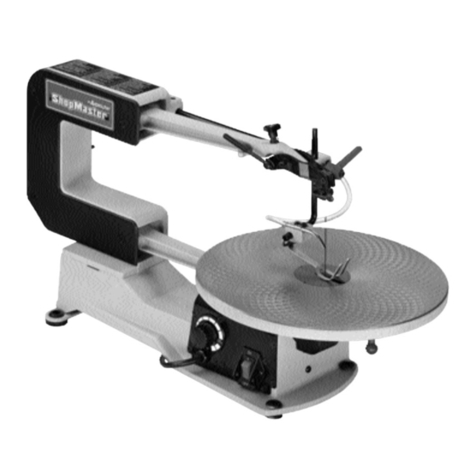
Delta
Delta 16 SM600 User manual
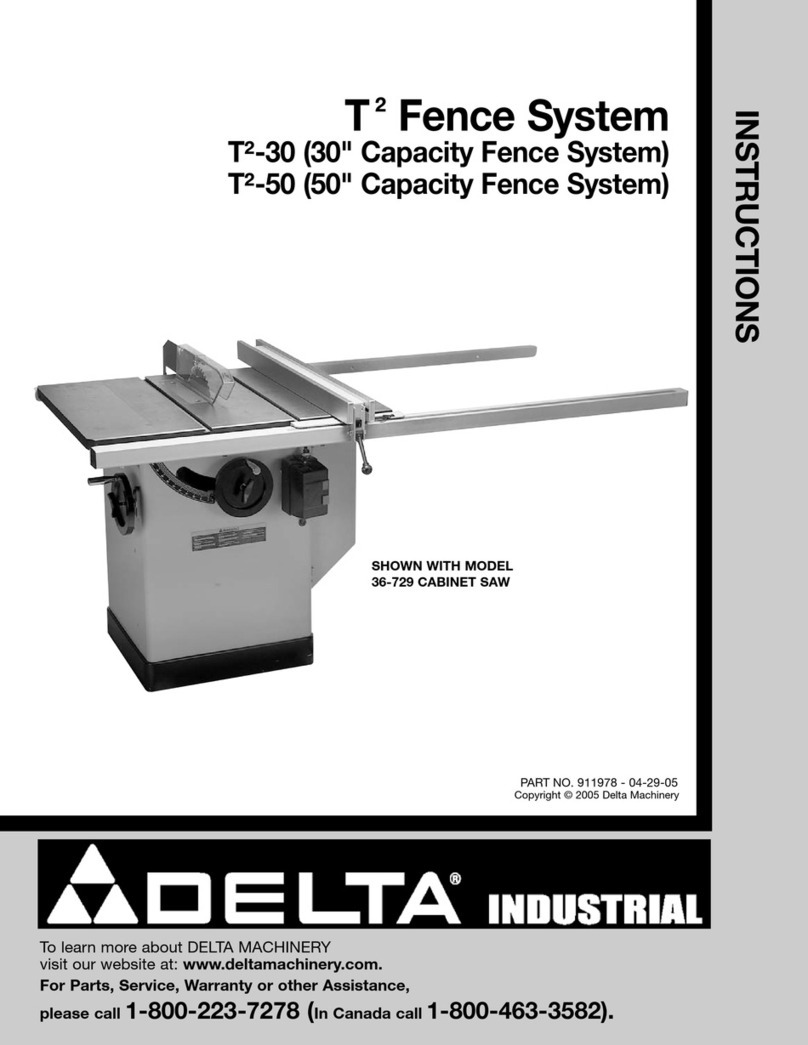
Delta
Delta T2-30 User manual
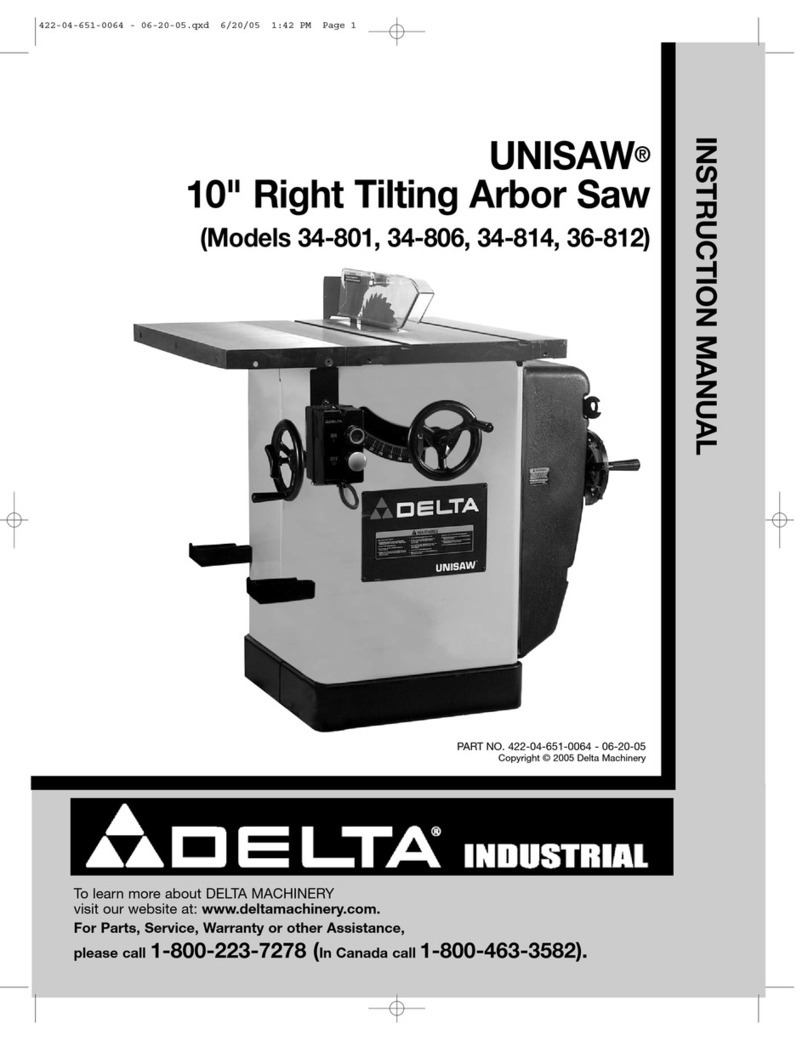
Delta
Delta UNISAW 34-806 User manual

Delta
Delta 36-725 T2 User manual
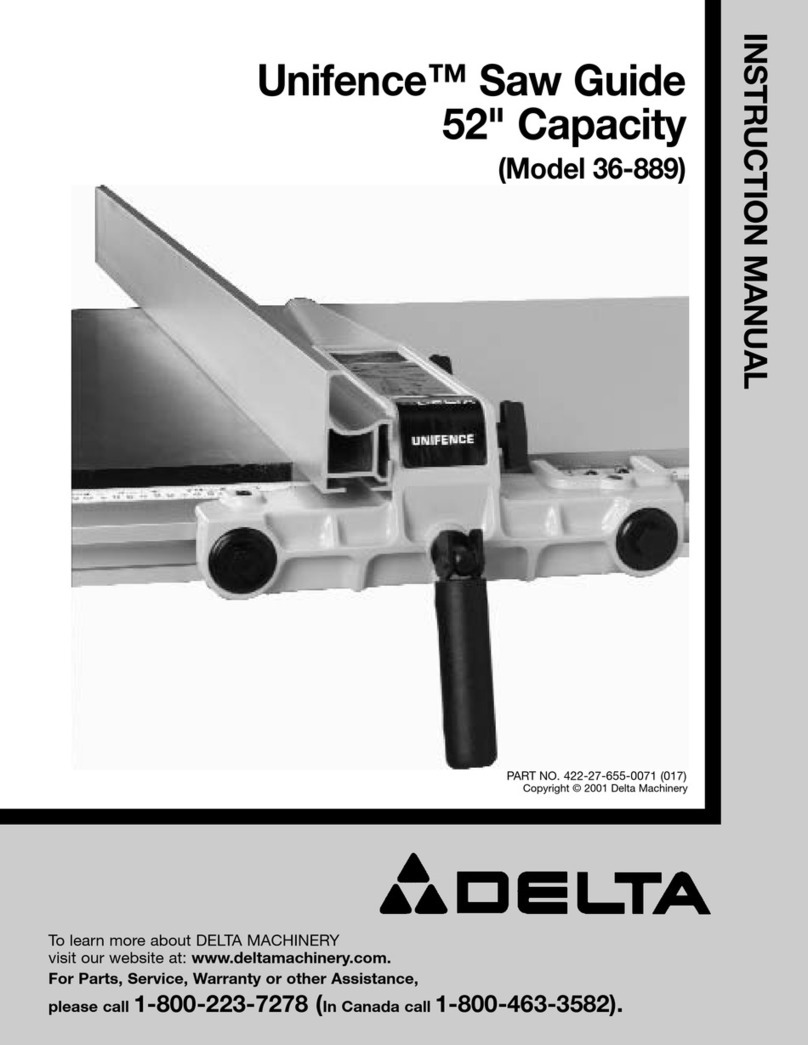
Delta
Delta 36-889 User manual
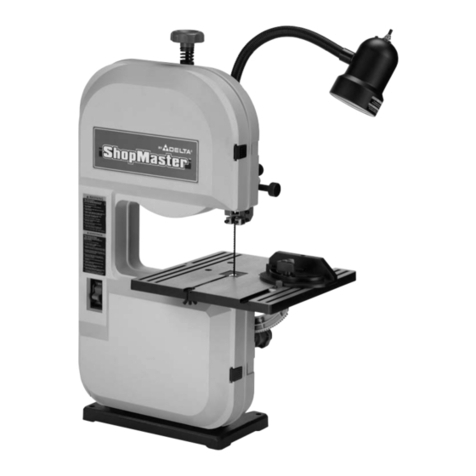
Delta
Delta ShopMaster 638518-00 User manual

Delta
Delta 422-04-651-0027 User manual
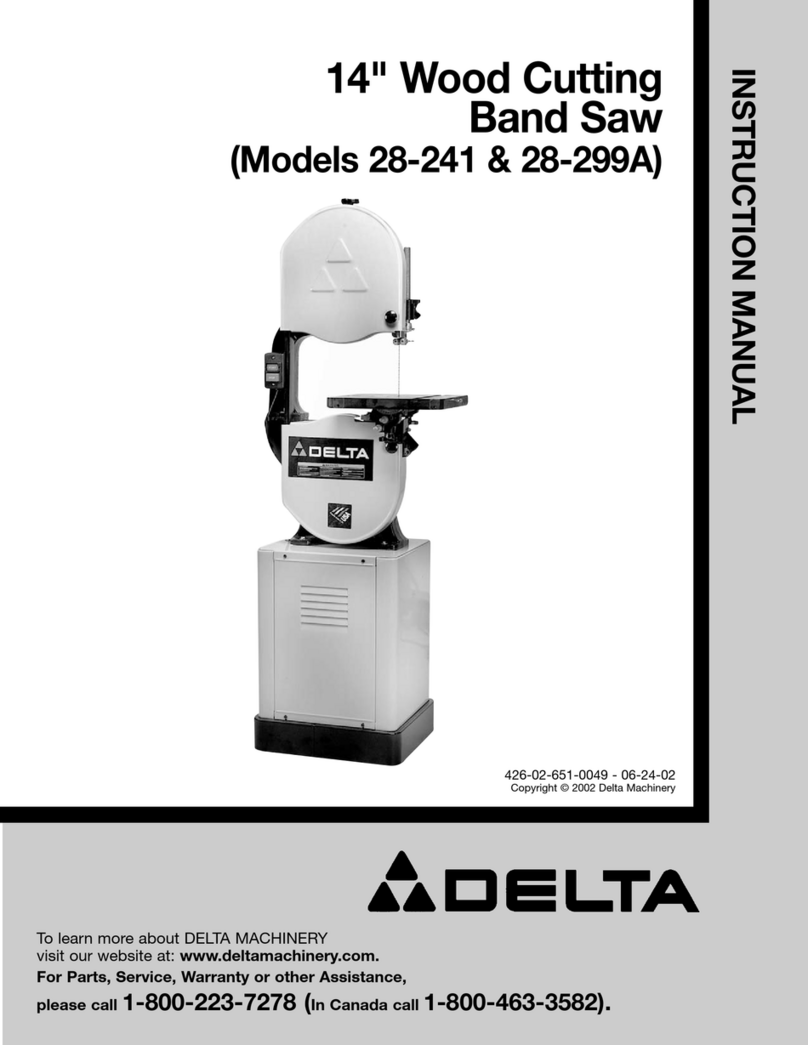
Delta
Delta 28-241 User manual

Delta
Delta 36-650 User manual

Delta
Delta 28-276 User manual
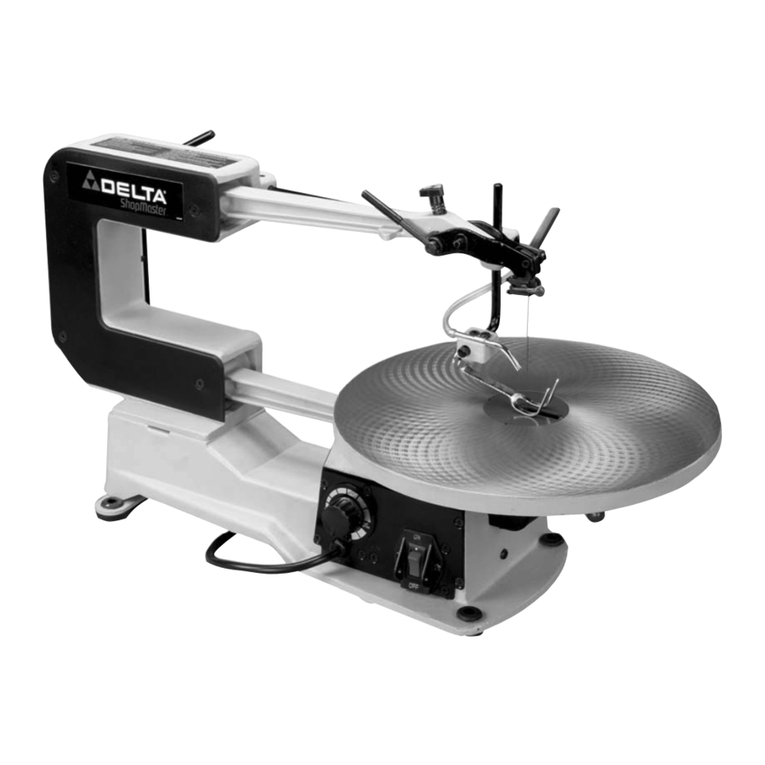
Delta
Delta SHOPMASTER SS250 User manual

Delta
Delta 36-412 User manual
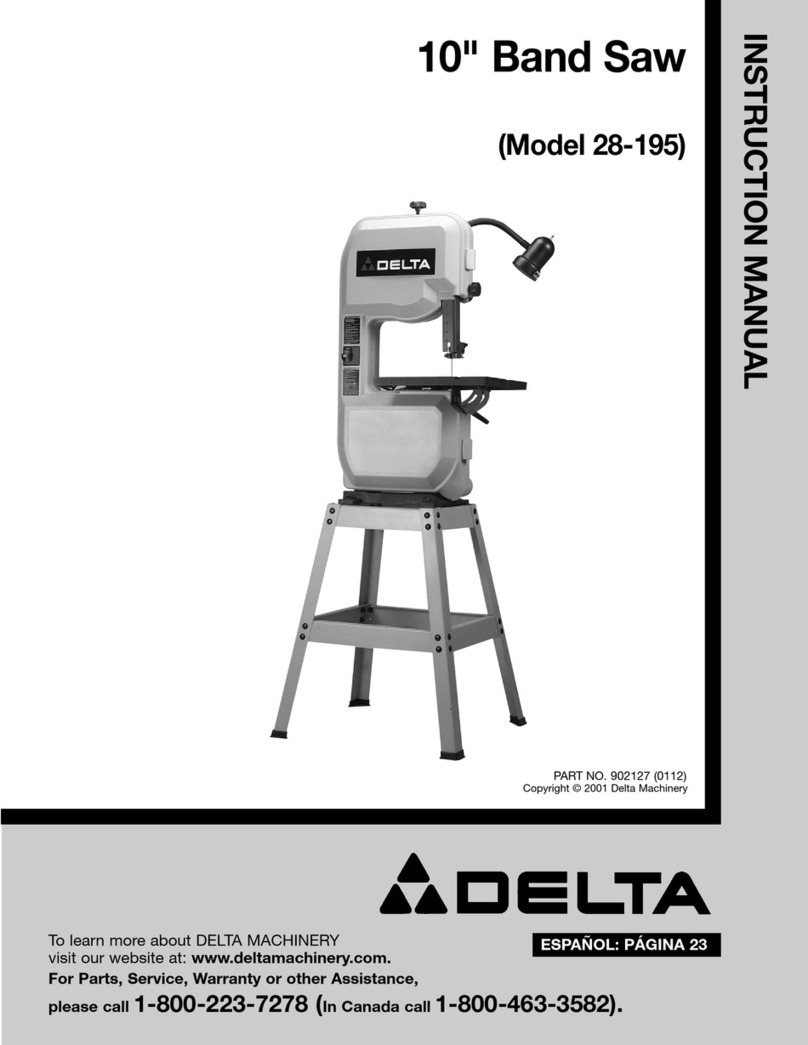
Delta
Delta 28-195 User manual
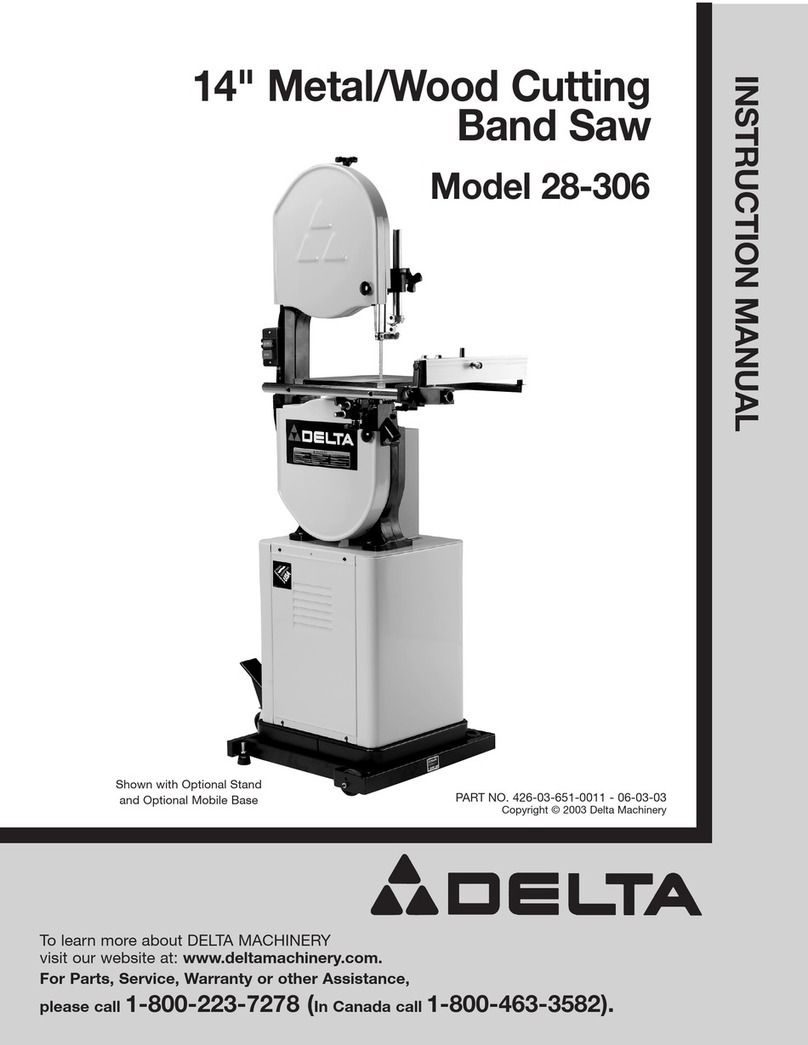
Delta
Delta 28-306 User manual
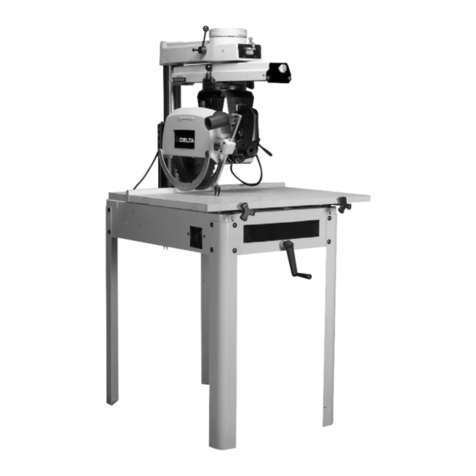
Delta
Delta 33-890 User manual
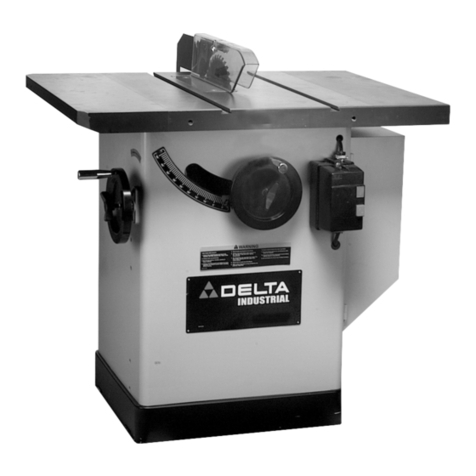
Delta
Delta 36-729 User manual
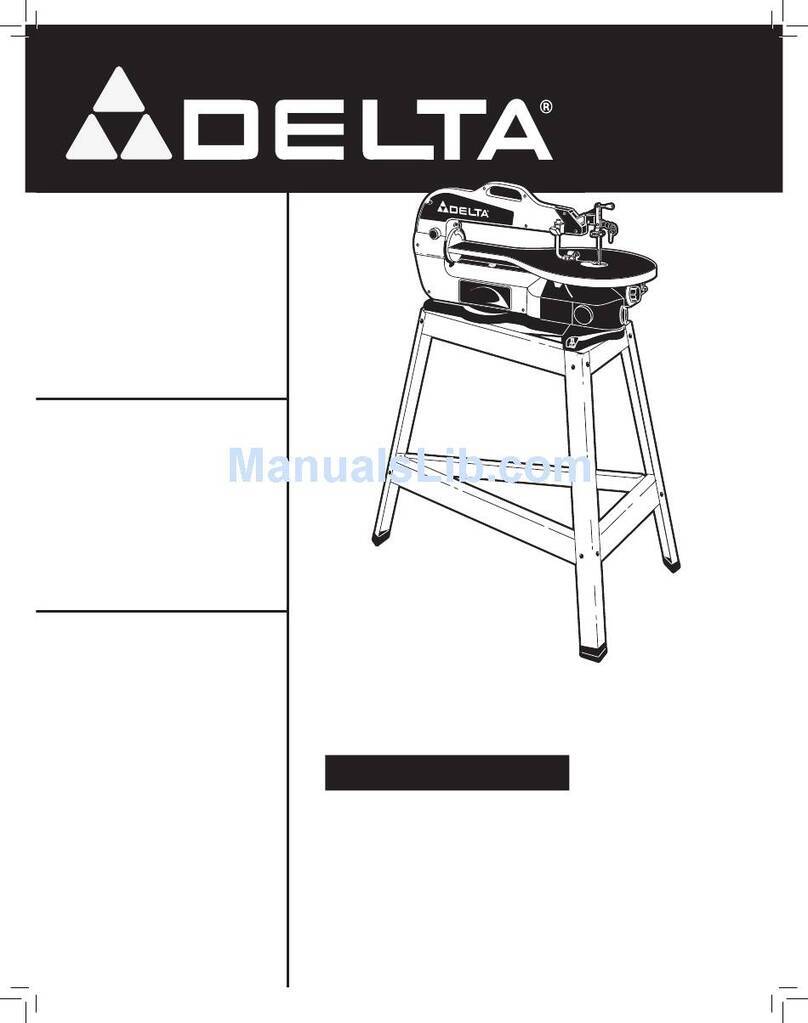
Delta
Delta SS350LS User manual
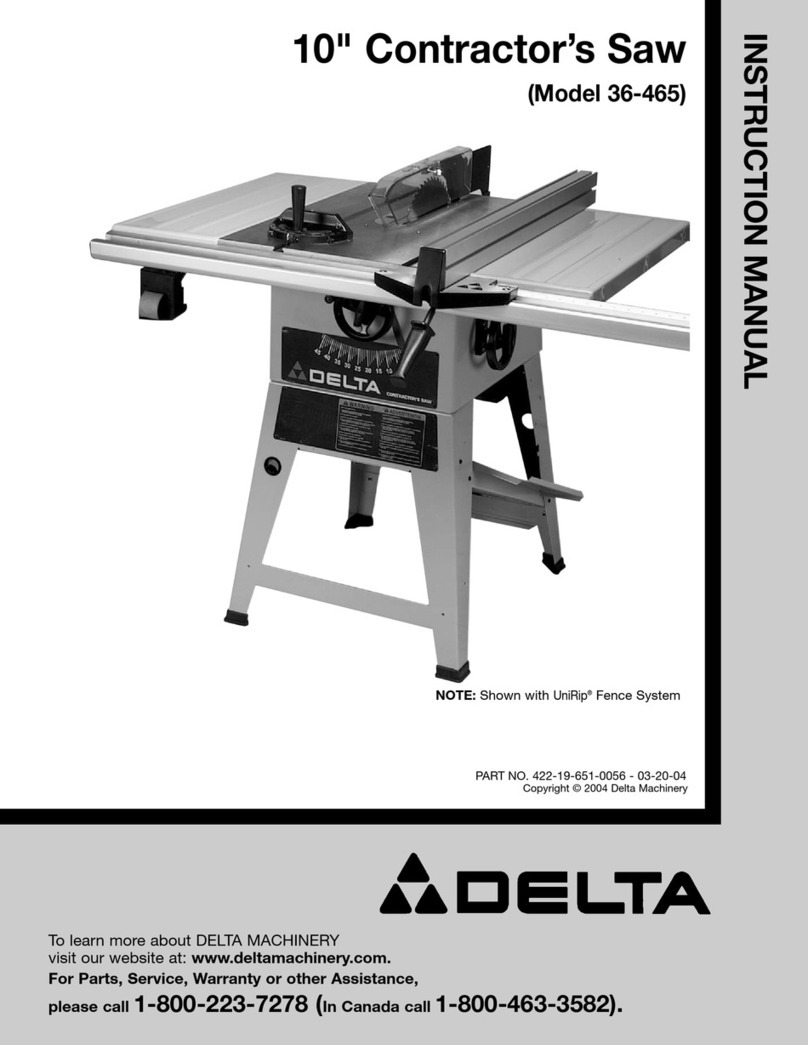
Delta
Delta 36-465 User manual
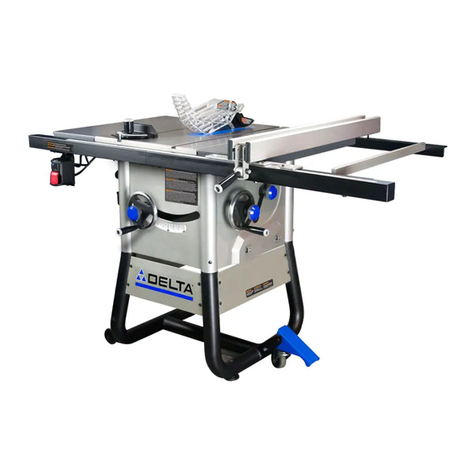
Delta
Delta 36-725 User manual

Delta
Delta 15'' scroll saw User guide
